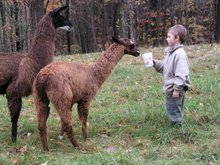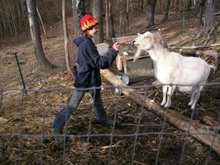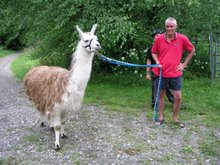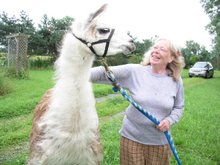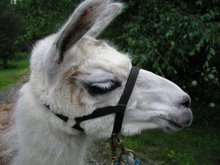
During this rescue of the NY 100, there have been so many people that have helped, donated and given everything that they could to help these poor llamas. I hope to get our donations page updated tonight. I will put the "State of Donation Origin" after the donors names, if the donation didn't come from NY. Gigi Davidson,DVM, North Carolina Vet College helped us get the vaccinations that we would need to give all of the new llamas their first round of shots. Destron Microchips donatated the chips and readers to permanently ID all of the llamas in Montana. Mary Smith, DVM, and over 25 of her vet students from Cornell University provided the labor. I am rarely speechless, yesterday was another one of those days.
Yesterday started out like any other day at our facility. Nice spring morning, a lot of very happy llamas waiting to see me when I stumbled into the barn around 530half asleep as usual. I got everyone up, eating and started to formulate a game plan for the huge surge of labor that I was expecting on the farm. By 10 am our webmaster and dear friend Gayle Nastasi rolled in. She had one of the toughest jobs yesterday, she had to photograph and record every llamas' microchip so that she could come up with a database, not just for our records but for the virtual adoption fundraiser that Josh and Brent are doing with the Beekman Boys friends and fans. Next came volunteers Viv and Bob Fulton, Ive known the Fultons forever. They have been packing with llamas forever and were quick to email me to let me know that they wanted to adopt five of the guys when they were ready. Turns out that the Fultons are going to adopt 6 llamas since they found a llama that they had parted ways with years ago. I am sure that Moody Blue will be the first of many llamas that we figure out where they originally came from. We have a long list of people looking for "lost" llamas, there was only one llama that we found a microchip in that wasn't our chip....we are figuring that out. There were some llamas with metal ear tags, we are figuring those out. Gayle will have the llamas head shot photos up online soon so people can start looking for llamas that they might have known. We also had 6 guys with (actually 12) surprises, 6 of the "geldings" were actually intact studs so the gang from Cornell took care of that problem as well before they left to go back to Ithaca.
Shortly after my friends and volunteers arrived, the students from Cornell started rolling in one car at a time. I was kind of surprised that Cornell didnt send a van but the cars kept coming one after the other until around 25 vet students and their teacher, Mary Smith, DVM arrived. I took them on a tour of the farm and showed them "everything that we do at the zoo" so to speak. Then it was time for a game plan. With this many people we had to divide up tasks. Some students worked the chute that the llamas were going through. Some students prepared the syringes with the wormer, the rabies or the C.D. and T vacinations. As we started putting llamas through the chute, we quickly realized that giving 3 shots, feelin' for testicles, takin an ID photo and reading a microchip wasnt going to go as quick as we had hoped for. Some of the students broke off and put 5-7 llamas in a horse stall. Then in groups of 2-3 vets they gave shots, body scored the animal and wrote any immediate medical issues that Dr. Smith needed to see on a plastic ribbion around the llamas neck. Once all vet work was done, they were put through the chute where the microchip was read, the photo was taken, the neckband was removed and they got to go outside and hang out in the beautiful spring sun with their buddies.
About halfway through the herd, we stopped and had lunch. Hubie's Pizzeria in town donated ten pizzas to the cause. I really appreciate Chris and Jenn Hubbard's help. Whenever they know I am working with a large group of students at the farm that need to be fed, they always take great care of us....Viv made some great cookies. Gail made some cupcakes.....most of the students were finished eating and back to the barn before I had my second piece of pizza.
Everyone was a bit slower after lunch but we finally started to get into the groove and got into the routine. Of course the llamas that were last to be done were the ones that were not our most willing participants. The day concluded with a special surprise for the 6 male llamas that snuck on the trailer to NY from Montana with everything that they must have been hiding a month ago.....We have 100% neutered males (or geldings) now. It was a long day but a great day. In a month the CD and T and the rabies should be repeated. We are also coming up with a game-plan for getting the guys sheared this spring. I think that we will shear 50 llamas one weekend, the other 50 llamas the next weekend. I am taking adoption applications now for the guys, even though they will not be adopted out until the weather breaks this spring. The llamas need to get sheared and get looking better. The adoption applications are available to print on our website, then mail them in. For people that can not afford the small adoption fee, we can talk and some of the adoption fees will be offset by virtual adoptions from our Beekman Boys friends.
Just Added:
Meet the Llamas HerePictures from Dr. Smith


NY Wildlife Rescue was called upon by the producers of the NatGeo show, Animal Intervention, to help with a case in upstate NY where a private zoo could no longer keep the animals. We were able to help by taking several bobcats and giving them a safe place to reside.













